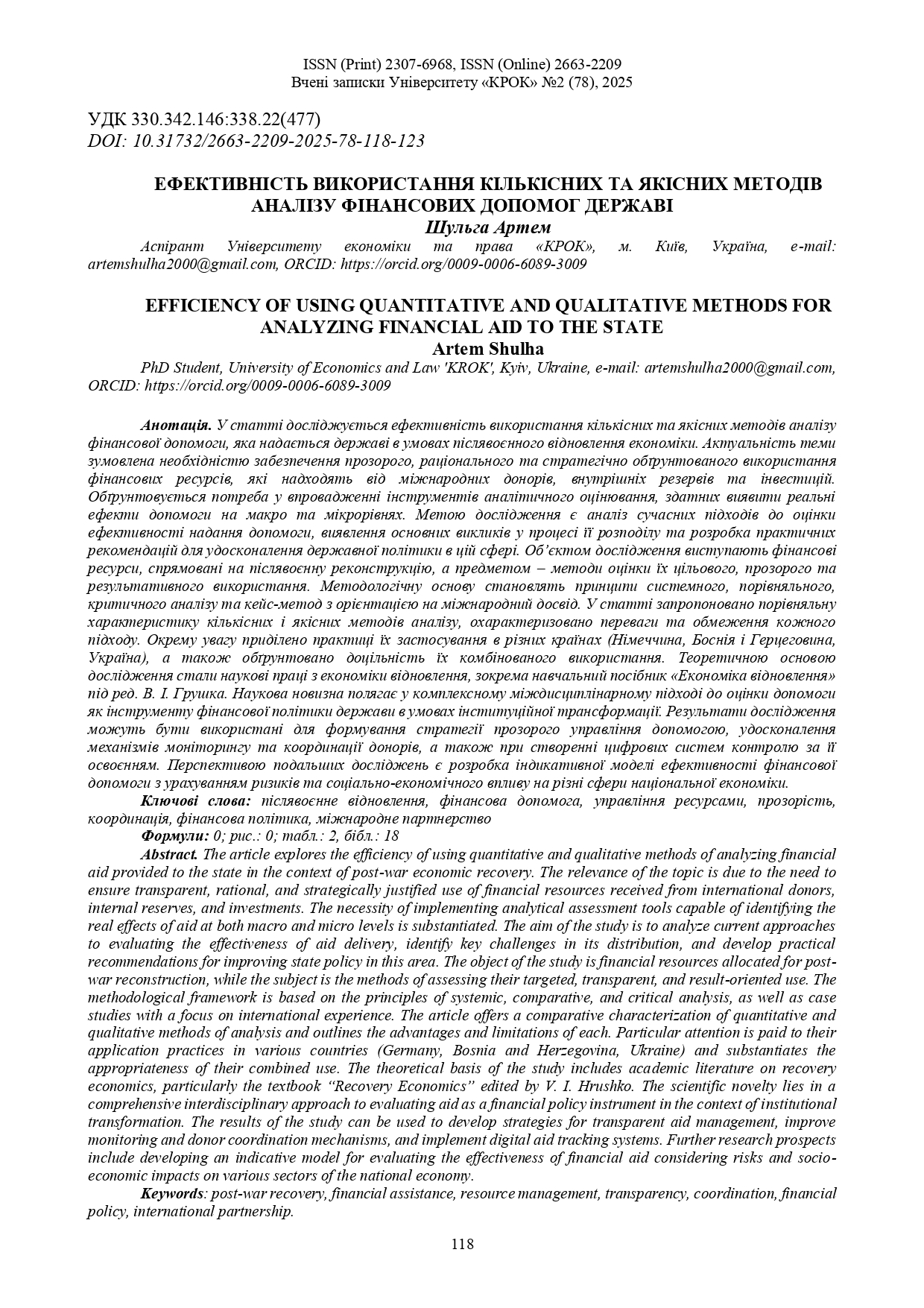EFFICIENCY OF USING QUANTITATIVE AND QUALITATIVE METHODS FOR ANALYZING FINANCIAL AID TO THE STATE
DOI:
https://doi.org/10.31732/2663-2209-2025-78-118-123Keywords:
post-war recovery, financial assistance, resource management, transparency, coordination, financial policy, international partnershipAbstract
The article explores the efficiency of using quantitative and qualitative methods of analyzing financial aid provided to the state in the context of post-war economic recovery. The relevance of the topic is due to the need to ensure transparent, rational, and strategically justified use of financial resources received from international donors, internal reserves, and investments. The necessity of implementing analytical assessment tools capable of identifying the real effects of aid at both macro and micro levels is substantiated. The aim of the study is to analyze current approaches to evaluating the effectiveness of aid delivery, identify key challenges in its distribution, and develop practical recommendations for improving state policy in this area. The object of the study is financial resources allocated for post-war reconstruction, while the subject is the methods of assessing their targeted, transparent, and result-oriented use. The methodological framework is based on the principles of systemic, comparative, and critical analysis, as well as case studies with a focus on international experience. The article offers a comparative characterization of quantitative and qualitative methods of analysis and outlines the advantages and limitations of each. Particular attention is paid to their application practices in various countries (Germany, Bosnia and Herzegovina, Ukraine) and substantiates the appropriateness of their combined use. The theoretical basis of the study includes academic literature on recovery economics, particularly the textbook “Recovery Economics” edited by V. I. Hrushko. The scientific novelty lies in a comprehensive interdisciplinary approach to evaluating aid as a financial policy instrument in the context of institutional transformation. The results of the study can be used to develop strategies for transparent aid management, improve monitoring and donor coordination mechanisms, and implement digital aid tracking systems. Further research prospects include developing an indicative model for evaluating the effectiveness of financial aid considering risks and socio-economic impacts on various sectors of the national economy.
Downloads
References
Bechara, A., Damasio, H., & Damasio, A. R. (2000). Emotion, decision making and the orbitofrontal cortex. Cerebral Cortex, 10(3), 295–307. https://doi.org/10.1093/cercor/10.3.295
CASE Україна. (2023). Аналітичний огляд ефективності бюджетної підтримки. Retrieved from https://case-ukraine.com.ua
Crowden, A. (2008). Professional boundaries and the ethics of dual and multiple overlapping relationships in psychotherapy. Monash Bioethics Review, 27(4), 10–27.
Eichengreen, B. (2007). The European Economy Since 1945: Coordinated Capitalism and Beyond. Princeton, NJ: Princeton University Press.
European Commission. (2021). EU Support to Western Balkans. Retrieved from https://ec.europa.eu
Грушко, В. І. (2023). Економіка відновлення: фінансова політика в післякризовий період. Київ: Університет «КРОК».
Дьяків, О. І. (2017). Фінансовий аналіз: підручник. Київ: Центр учбової літератури.
IMF. (2023). Ukraine: Extended Fund Facility. Retrieved from https://www.imf.org
Інститут економіки та прогнозування НАН України. (2022). Щорічна доповідь про макроекономічну ситуацію в Україні.
Крамаренко, Г. О. (2020). Кількісні та якісні методи аналізу економічних процесів. Економічний вісник, (4), 45–53.
Kyiv School of Economics. (2023). Аналіз використання міжнародної допомоги: виклики та можливості. Retrieved from https://kse.ua
Marshall Plan Aid. (1948–1952). Economic Cooperation Administration. Retrieved from https://www.marshallfoundation.org
Міністерство відновлення України. (2023). Електронна платформа eRecovery. Retrieved from https://erecovery.gov.ua
Міністерство фінансів України. (2023). Інформація про надходження та використання міжнародної допомоги. Retrieved from https://mof.gov.ua
OECD. (2021). Quality Standards for Development Evaluation. Retrieved from https://www.oecd.org/development
OECD. (2022). Ensuring the Effective Use of Development Finance in Fragile Contexts. Retrieved from https://www.oecd.org
Transparency International Ukraine. (2023). Моніторинг використання державних коштів в умовах війни. Retrieved from https://ti-ukraine.org
U.S. Bureau of Economic Analysis. (2022). National Economic Accounts. Retrieved from https://www.bea.gov
Світовий банк. (2023). Ukraine Economic Update. Retrieved from https://www.worldbank.org/en/country/ukraine

Downloads
Published
How to Cite
Issue
Section
License

This work is licensed under a Creative Commons Attribution-NonCommercial 4.0 International License.

